Enfield Board slates “Terms Laws” for November ballot
by Robert Lynch, July 28, 2021
With Public Hearing attendance lackluster, and with lawmakers holding only enough votes for a quorum, the Enfield Town Board Wednesday (7/28) advanced to the November election three local laws that would double the length of terms for three Town Offices, including that of Supervisor.
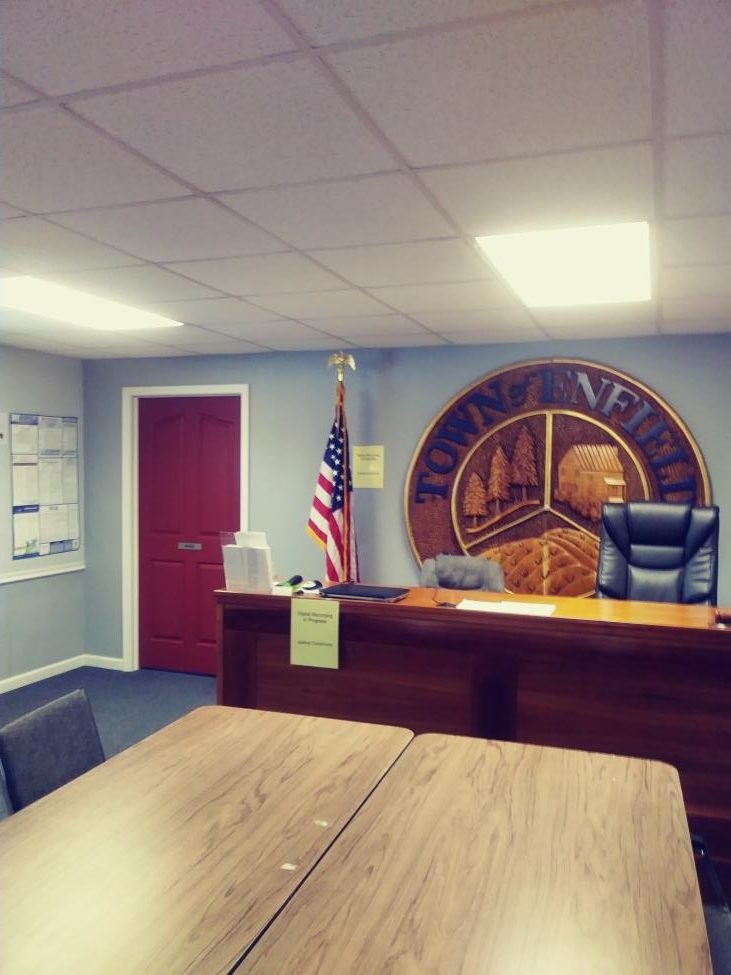
By a series of unanimous votes among the three members present, the Board scheduled for a fall trio of referenda laws that would extend from two years to four the future terms not only for Town Supervisor, but also for Town Clerk and Highway Superintendent. As was made clear by technical amendments adopted on the floor, the four-year terms, if supported by voters, would not begin until after the November 2023 elections.
The Board required unanimity Wednesday because Councilperson Virginia Bryant was excused to attend a family matter, and her colleague James Ricks failed to attend.
Wednesday’s action—and mood—served as a far cry from that of one year ago when proposed laws, advanced by then-Supervisor Beth McGee, would have eliminated the elected positions of Town Clerk and Highway Superintendent, replacing them with appointed officers. McGee’s measures drew strong public outcry, a citizen petition, and then lost at the polls by four-to-one margins.
Voters want us to “play in sandbox,” said Councilperson Robert Lynch (this writer) in joining Supervisor Stephanie Redmond and Councilperson Jude Lemke Wednesday to put the three terms’ changes on the ballot. Though Lynch openly questioned the three proposed laws and indicated he might oppose them in November, he joined Redmond and Lemke after the Supervisor assured him that Bryant would have voted affirmatively had she been present. With the Board’s senior member absent, Lynch’s dissent could have blocked sending the laws to the voters. But had Bryant attended, Lynch, had he dissented, would have found himself outvoted.
Lynch said he didn’t want to play the games of Washington politicians and “filibuster.”
But the Councilperson did score some procedural points along the way. On each of the three measures, the Board adopted Lynch-backed amendments that stripped from the Resolutions their initial judgmental wording that had implied the Board supported the longer terms. Substitute phrasing stated that the Board believes “the Town will be best served by allowing the Town of Enfield’s electorate to decide” the matter.
Supervisor Redmond has repeatedly maintained she seeks only to give the voters the choice, stating at an April meeting when she proposed the new laws, “I don’t really feel comfortable influencing resident opinion on this because I don’t want to be seen as weighing in one way or another.”
But on perhaps a more significant point, one addressing concerns raised by former Town Clerk Ellen Woods, the Board, at Lynch’s request, removed wording Redmond had scripted that “recognizes that the Office of Town Supervisor is a full-time position.” The Town Board has never formally defined the Supervisor’s commitment, and Woods has complained that classifying it as “full time” in the local law could set the stage to vault Supervisor’s salary far above that for Town Clerk.
“It’s far more than a full-time position” Redmond told the Board Wednesday. “It sucks up my entire life.” Yet Redmond agreed to excise the defining language. Lynch said later that he preferred the issue of term lengths not get sidetracked.
In her own written comments at the Public Hearing, read into the record by Lynch at the former Clerk’s request, Woods insinuated full-time Supervisor’s status was, in truth, Redmond’s true reason for advancing her office’s longer term, as Woods claimed it was for Redmond’s predecessor, Beth McGee.
“It was inappropriate then and now to sneak something regarding the Town Supervisor being a full time job into this law,” wrote Woods. “A large amount of the work of the Town Supervisor is discretionary and allows the Supervisor to pursue their personal policy goals.”
Along with her comments, Woods submitted a petition signed by some 69 people—not all from Enfield—that urged support for paying Enfield’s Town Clerk a Living Wage. As Town Clerk and Tax Collector, the Clerk currently earns $24,000 annually for a job generally regarded as part-time.
Also as part of the amended language adopted Wednesday, the Board removed from the proposed law affecting the Town Clerk’s term a phrase that defined the Town Clerk as “predominately a clerical position within Town Government, not one of general legislative policy formulation.” Woods had characterized the “clerical” classification as “pink collaring.” In proposing removal, Lynch said he didn’t want the Board to be seen as “misogynistic.”
Aside from former Clerk Woods, only Marcus Gingerich, a frequent meeting attendee, addressed the Wednesday Public Hearing. Initially confused into thinking the Board could extend terms without a referendum, Gingerich said he was “really torn” about whether longer or shorter terms are better.
“I can see both sides of it,” said Gingerich. Four-year terms permit an office-holder to gain more experience. Then, again, he opined, with a shorter term, “If a Supervisor is really not doing a good job, you can (more quickly) kick him out.”
###
You Go First
Newfield Board poised to take lead and adopt Stretch Code

by Robert Lynch, July 23, 2021
Only 14 other upstate communities have adopted the ambitious, eco-friendly Stretch Code, Taitem Engineering’s Lou Vogel told the Newfield Town Board Thursday night (July 22nd). But in a few weeks, Newfield could become the fifteenth.
In a decision which may fall along party lines, the Newfield Board could at its next meeting, August 12th adopt what’s been thumb-nailed “NY Stretch,” a set of energy conservation building standards that New York gives municipalities the option of adopting voluntarily, but that Green New Deal advocates would like to see mandated everywhere.
“We don’t have any time to wait on climate action,” Newfield resident Michelle Henry told a Town Board-sponsored Public Hearing Thursday evening prior to Board discussion about the code’s potential adoption by her Town.
Like Henry, Leo Tidd, Chair of the Newfield Planning Board, urged the Town Board to adopt NY Stretch, predicting the heightened standards would add only “a modest, incremental cost” to new homes and will not affect the number of them being built.
Stretch Code consultant Vogel told the Board and hearing attendees that for residential properties the code would require better windows, more efficient lighting, shorter water piping, and properly sized heating ducts. But perhaps most controversial, as far as those at the meeting were concerned, the Stretch standards would require breaker panels adequate enough to accommodate future solar power and electric vehicle charging units. They would also require a conduit be run that might someday carry wires to charge an electric car.
“At what point do we stop dictating what people have to do?” questioned resident John Schulte. “I object,” he said, to these regulations “being thrust down our throat.”
Schulte found support in some official circles, particularly with Councilperson Christine Laughlin, the Newfield Board’s lone Republican.
“It should be the people’s choice,” said Laughlin, maintaining that the heightened standards—and that EV charging conduit—should be put in only if the homeowner wants it. “I’m not in favor of requiring it,” Laughlin said.
But a read of the room Thursday suggested the final show of hands in August may mirror the members’ party registrations. The three Town Board Democrats, to varying degrees, appeared to support NY Stretch. Republican Laughlin would likely oppose it. And Supervisor Michael Allinger, a registered Independent, expressed no clear preference, voicing equal degrees of support and skepticism. If the voting paralleled party lines, however, NY Stretch would pass.
“It’s kind of like smoking,” said Councilperson Heather McCarty, perhaps the Board’s most passionate supporter of NY Stretch. When scientists found cigarettes harmful to health, the government stepped in. So, too, here, she argued, maintaining that any energy savings, although marginal, will do their part to save the planet.
“Not taking action is not taking responsibility,” McCarty insisted. “We’ll be doing our part to make sure life as it is continues. I’m pretty scared about what the future looks like for our kids.”
McCarty’s fellow Democrat, Casey Powers, opined that “it’s a really good thing” that homebuilders would have to run a conduit to encase a future EV charging cable. Argued Powers, if the conduit’s run, perhaps the owner will more likely buy an electric car.
With the required Public Hearing already having been held earlier that evening, Powers moved to adopt the Stretch Code on the spot. But after others signaled the Board might be moving a touch too fast, members tabled Powers’ motion to allow further thought.
Supervisor Allinger—hard to read as to his final vote—on the one hand, said he’d like to see developers take the initiative on heightened standards and not shirk their responsibility; but on the other hand questioned whether requiring breaker space for EV charging might limit the capacity of a typical 200-amp service.
The final Board member, Democrat Joanne James, though less outspoken, seemed sympathetic to arguments by her party colleagues.
“I believe in science,” said James. “There are fires out west. Torrential rains are worse. I believe climate change is causing it.”
So if a vote for NY Stretch is a vote for climate stability, one could infer James is on board as well.
Consultant Vogel, nevertheless, cautioned not to fear the Stretch Code’s impact beyond its true reach. “It doesn’t apply to homes that have wheels,” he said, leaving mobile homes exempt. If an addition were built, the existing home, he said, would not require an upgrade to meet the code. Applicability to renovations would depend, he said, upon the renovation’s extent.
State calculations, which Vogel cautioned were written pre-pandemic, estimated that a typical home’s meeting the Stretch Code could add about $1,900 to construction cost, but achieve a 4.4 year payback, saving about $430 each year on energy.
Experts have predicted elements of NY Stretch will soon be incorporated into New York’s standard building code, usually updated every two years. But when they are, even newer Stretch standards would likely come forth.
But for now, if adopted in August, Newfield would become Tompkins County’s first rural town to embrace these more ambitious standards. Although the City of Ithaca’s Green Building Code adopts some of Stretch’s guidelines, Newfield would beat Enfield, Danby, and Caroline, all of which have been approached about Stretch, but have not yet acted.
###
County “Cash for Capital” wins the race for federal funds
by Robert Lynch, July 20, 2021; updated at 10:57 PM
Rich John would shore up food pantries. Shawna Black would give each of a half-dozen key administrators Ten Grand bonuses. Dan Klein would grant each legislator a tenth of a Million just to fund pet projects. And Mike Sigler would cut tuition at TC3 and “fill every pothole; every… single… one.”
But far more likely—and after a key committee vote Monday, a virtual certainty—Tompkins County legislators will plop three-quarters of Uncle Sam’s nearly $19.9 Million of local post-pandemic aid into a colorless category called “cash for capital,” spiriting it away to subsidize future brick-and-mortar projects, not the least of which could be a new downtown office building.
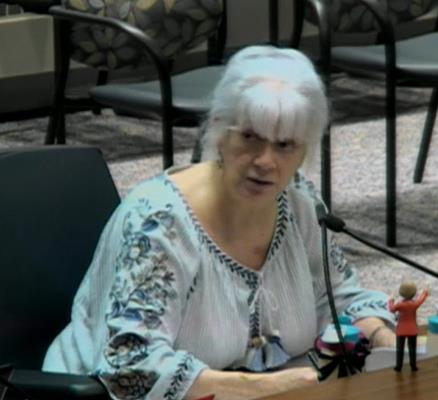
Indeed, one night later (Tuesday, July 20th), the full Legislature—its membership almost the same as 24 hours earlier—ratified the Budget Committee’s action, eleven votes to one.
“We’re so far from being out of the woods… we don’t know what we’ll be facing down the road,” said Budget, Capital, and Personnel Committee Chair Deborah Dawson Monday, as she urged fiscal frugality in the face of whatever COVID-19 has yet to hurl at her community.
Grasping at accounting straws that federal officials have yet to fully explain, Dawson’s Budget group—joined by most other legislators meeting as a committee-of-the-whole— adopted a pair of recommendations to allocate all of the County’s expected proceeds from the American Rescue Plan (ARP). The first of the motions, now official, dedicates all moneys to “fund government operations.” The second, more controversial, recommendation assigns three-quarters of that operational total to fund “cash for capital.”
By spiriting 75% of the ARP into the capital fund, the County might save money long-term on its bonding costs. But the assignment would also make it easier to dip into the capital account to support favored projects—like the office building—with lawmakers knowing they’d not be asking taxpayers to shoulder the expense directly.
Nonetheless, in locking away all of the proceeds under the title of “operations,”—effectively, compensating for theoretical revenue shortfalls that in some respects never really occurred—legislators would lose a level of flexibility in how they can spend the funds. For example, if filtered through local coffers, the County could not easily and directly subsidize private parties. But if the money were left non-operational, the county could funnel checks directly to people and businesses.
“We’re setting ourselves up so we can’t go back,” cautioned Ulysses-Enfield legislator Anne Koreman, who voted against the full-funding to operations, but later supported the cash for capital assignment.
Only Ithaca legislators Henry Granison and Leslie Schill voted against both the operational assignment and the cash for capital option Monday. (By attending remotely, Schill’s vote couldn’t count. Legislature Chair Leslyn McBean-Clairborne had been excused.)
With both Schill and McBean-Clairborne excused when the Legislature met again Tuesday, only Granison dissented on the 75 per cent capital set-aside.
Indeed, during Monday’s discussions, Schill proved the meeting’s most powerful critic of both Budget Committee recommendations, the Ithaca Democrat stressing the need for helping people recover in a way that’s consistent with the ARP’s true purpose.
“We are not getting to the pain places,” complained Schill.
“There is an immediate and an acute need which is the reason the funding is coming our way because of the pandemic,” Schill continued. “And I think we have an obligation to respond to that at the human level and not thinking necessarily only about the long term fiscal health of the County.”
Schill, who lost a recent primary and will be leaving her brief stint on the Legislature at year’s end, urged the more-flexible use of ARP funds to aid households, individuals, businesses, and what she termed “potentially transformational projects.”

“I am concerned that we will not be helping some folks that are in real need,” the Ithaca legislator maintained. “We will not be supporting economic revitalization of the county, and that would be a big loss. It will come back to roost.”
Schill’s priorities Monday placed her squarely at odds with Budget Committee Chair Dawson, who sets spending priorities with the discipline of a green-eyeshade taskmaster, and who lives her life in continual fear of the COVID-19 Delta Variant.
“To me, throwing money at an economy with the idea that we’re going to resuscitate it just so that we can shut everything down again… makes no sense, whatsoever,” Dawson said.
There’s a reason Dawson is called “Debbie Downer.”
Though it was by no means scientific, a recently-conducted, County-sponsored opinion poll put local residents on Schill’s side, with 57 per cent of the survey’s nearly 2000 respondents having ranked compensation for COVID-affected households as among their top three spending priorities for ARP funds. Helping struggling businesses and non-profit agencies came in second.
Newfield-Enfield legislator Dave McKenna told the committee he’d favor throwing all of the ARP money into the capital account, so long as the County could tap other resources—perhaps from its Fund Balance—to put as much as $3 Million toward expanded broadband.
After their two key votes Monday, legislators spent the rest of the meeting discussing how they might tap their admittedly bloated Fund Balance to support, as much as they can, those human needs lawmakers like Schill want addressed. Wanting firmer Fund Balance figures first, they delayed any recommendation that would carry a dollar figure.
****
When Monday rolled into Tuesday and the County Legislature readied for its final vote, Legislator Koreman tossed in a surprise. Rather than direct all of the ARP funds to “government operations,” Koreman proposed a meager five per cent of the total—just over $992,000—be shunted aside for “non-County spending,” funding to satisfy those household, individual, and business subsidies the County might find itself otherwise barred from spending.
But in part because some legislators feared it could impose what Shawna Black termed a “reporting nightmare,” Koreman’s amendment failed, eight votes to four.
“God, people, can’t we just make a decision and stick to it?” a petulant Dawson implored her colleagues.
“Not everybody decided this last night,” Koreman reminded the Budget Chair. Many, like Schill, she said, had wanted at least 25 per cent set aside. And should County Government become the program’s lone recipient, the only recourse might require “some convoluted way to wash the money… to give it back to the community; to buy kids shoes so they can go back to school.”
Tuesday’s resolution, while committing three-quarters of Rescue Plan funds to the capital program, also diverted money a second way, carving from the remaining amount an estimated $100 thousand to hire a full-time budget analyst to manage the ARP.
****
The agenda for Monday’s meeting had called for members to each discuss their “ARPA Vision Statements,” which 11 of the 14 legislators had drafted and which staff had posted online. For reasons unexplained, Dawson never called for that discussion. But the printed answers revealed a wide range of divergence.
Leslie Schill would prioritize food security funding, provide premium pay to essential workers, abate property taxes, and dabble in Ithaca’s Waterfront Development. Koreman would expand operations at the ReUse Center. Perhaps the most creative, Lansing’s Mike Sigler would convert the 13 foot dam on Six-Mile Creek into a power generation station. He’d also fill every pothole, restore swimming to Stewart Park and plant 100,000 trees, if not a million.
Danby’s Dan Klein would divide $1.4 Million of the total 14 ways, giving each legislator $100,000 to “allocate as they wish.” Klein would also like to improve cell phone coverage. Klein said he hears from constituents “that do not have sufficient cell phone reception to reliably hold a conversation.” He notably added, “My house is such a spot.”
###
County Committee seeks to raise new Administrator’s pay to $160 Grand
by Robert Lynch, July 19, 2021
Tompkins County’s next Administrator could be earning more than any other County Administrator or elected County Executive in upstate New York.

At a meeting that often resembled that of a company Board of Directors locked in a bidding war for a dream CEO, a committee of the Tompkins County Legislature Monday (7/19) set $160,000 as the target salary for the next County Administrator, an 18.5 per cent increase over that earned by the recently-departed Jason Molino.
The $160,000 figure would place the new hire for a county with a population of about 100,000 in line with that of the elected County Executive of Westchester County, whose 2020 salary, according to media reports, was $160,760. Westchester’s George Latimer oversees a county with nine times as many people.
“I thought for some time that our County Administrator is underpaid,” Dryden Legislator Mike Lane told the Budget, Capital and Personnel Committee Monday afternoon. “And I think it’s going to be a problem for us to recruit (Molino’s successor) unless we have a better pay scale.”
Lane suggested the County Administrator’s pay be equated with that of Tompkins Cortland Community College’s President, Dr. Orinthia Montague, who lawmaker reported was hired in 2017 at $170,000, plus a car and other benefits.
Although the committee’s Resolution outlining a job description, salary, and other recruitment details had not been posted on the Legislature’s web portal by meeting time, member comments indicated that County H.R. Commissioner Ruby Pulliam had recommended the $160,000 salary. Comments also indicated that the County intends to use the Pinnacle Group executive recruiting service as its headhunter.
Even so, the $160,000 salary—some $25,000 above Molino’s 2021 compensation of $135,012—was still not high enough for some on the committee, including Groton’s Glenn Morey.
“I’d also be happier with $175,000,” Morey said in answer to Lane’s support for $160 Grand.
No one at the meeting suggested keeping the Administrator’s salary at what Molino had earned. When he was recruited in 2018, Molino, according to sources, had, himself, negotiated his starting salary to a level above what his predecessor had earned.
Legislator Leslie Schill suggested the County set a hiring range for a new Administrator, perhaps ranging between $150 and 175 thousand, Schill suggesting flexibility could adjust pay to accommodate “a great up and coming” candidate.
Legislator Shawna Black concurred, suggesting a salary range would “help with attracting talent for this position.”
But while members kept the salary range option alive, Dryden’s Martha Robertson objected to setting a firm figure above $160,000.
“It sends a terrible message to the rest of our staff if we go as high as 175,” Robertson warned. The next lower tier of administrative pay scales, with salaries the Planning Commissioner and Director of Finance earn, pays just under $123,000.
“If we hire a rock star, we negotiate,” said Robertson.
Though agreeing on the $160 thousand figure, Budget Committee Chair Deborah Dawson reasoned. “If we get a rock star, and there is a tough negotiation, we may be able to eke out a bit more.”
Though never stated, the committee’s action Monday sent a not-so-subtle message to internal candidates that they need not apply. Two likely internal aspirants, Acting Administrator Lisa Holmes and Deputy Administrator Amie Hendrix, each, by contrast, according to the published pay scale, earn just $101,462. In fact, committee members remarked that with the scale they’re setting, many County Administrators from other upstate counties are apt to tender resumes.
The job search firm ZipRecruiter lists the average pay for a County Executive in New York State as $72,687, with the 90th percentile quoted at $146,431. The firm places the highest paid County Executive at $148,077, listing any salaries above that as “outliers.”
Legislator Schill told her committee colleagues that the elected mayor of Rochester earned $145,000 in 2019; the mayor of Syracuse $115,000.
To supplement the Administrator’s salary set Monday, the Budget Committee also tacked on a “relocation allowance” of as much as $8,000 for any out-of-town hire. Members declined to go so far as pay “first and last month’s” apartment rent should the recruit need to stay in a hotel prior to a family move.
With the committee advised later that evening that Tompkins County actually made money during the pandemic, its fund balance growing almost $2 Million between 2019 and 2020, Monday’s executive salary decision carried, at times, a “money is no object” message.
“The County Administrator has to supervise so many departments, take communication from so many legislators, and also respond in an emergency like we’ve had this past year,” said Legislator Lane. “I think it’s an important position that deserves to be adequately paid.”
“I think there is a rationale for going slightly above the current salary in upstate,” echoed a somewhat boastful Rich John, “in that we are the best county.”
And also, some might say, the richest and most generous.
###
Solar in a “Sour Spot”
Enfield Board, County agency at odds over solar farm compensation
by Robert Lynch, July 18, 2021
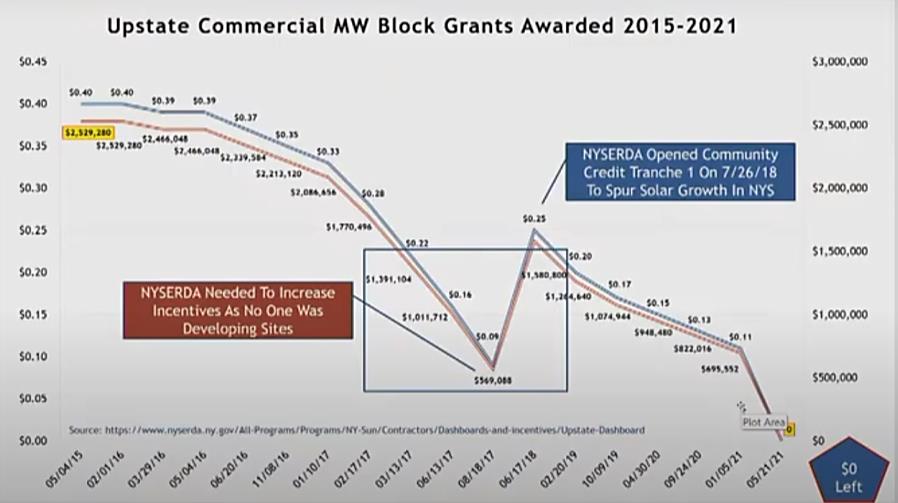
“Anything beyond 42 Hundred, it breaks this project; the financials don’t work.”
With those words, David Norbut, whose firm has proposed to build a $20 Million solar farm off Enfield’s Applegate Road, warned the Tompkins County Industrial Development Agency (IDA) Wednesday, July 14th that if the IDA imposes a Payment in Lieu of Tax (PILOT) Agreement any higher than $4,200 per Megawatt, or if Enfield tacks on a Host Community Agreement that would push total compensation above that figure, his project is a non-starter; it would likely never get built.
“The IDA is really playing hardball,” Councilperson Robert Lynch (this writer) later that evening advised his Enfield Town Board. Lynch, who’d relayed the Town Board’s own position to the IDA that afternoon, reported to his colleagues the earlier meeting’s take-away: “It doesn’t look good for Enfield.”
The IDA Board, by unanimous vote, agreed Wednesday to advance to a Public Hearing the proposed Norbut PILOT. The draft plan would assess Norbut Solar the $4,200 per Megawatt initial year’s payment, stretch the inflation-adjusted tax abatement over 30 years, and decline to require the Host Community Agreement Enfield had requested, compensation that would otherwise sweeten finances for the Town.
The Public Hearing will be held in Enfield, at a date and location as yet unspecified. It would likely take place sometime before the IDA Board’s next meeting August 11th. (The Town Board will meet the same night.)
Responding to the IDA’s just-adopted hardline stance, the Enfield Board Wednesday adopted its own tough Resolution, one stating that the IDA’s PILOT proposal “stands unacceptable to the Town, absent an accompanying Host Community Agreement.” It continued, “The TCIDA should stipulate the requirement for said Host Community Agreement within any PILOT Agreement the TCIDA negotiates with Norbut Solar.”
From appearances, the Town and the IDA appear dug in, but with one important distinction: The IDA can impose a PILOT at a level it sets. But the Town apparently has no legal right to impose Host Community compensation on top of it.
“We did the math,” Lynch told the IDA Board at the start of its meeting, “and it shows that … if we just have a strict PILOT… our Enfield would suffer financially because of it.”
“We really think that the Enfield Town taxpayers cannot really take it on the chin here.” Lynch told the IDA.
According to the Councilperson’s calculations, Town taxpayers would lose $12,910 in revenue the first year should the IDA impose a strict PILOT, as opposed to assessing Norbut the same amount through a hybrid of a reduced-rate PILOT coupled with a Host Community payment. The difference for Enfield arises because any PILOT payment gets split between three taxing jurisdictions, with the Ithaca City School District receiving the largest share. But when an Enfield-only Host Community Agreement syphons off some of Norbut’s money, Tompkins County and the School District get much less.
“I can’t see us changing this division of the tax revenue to benefit one individual municipality,” said IDA Board member John Guttridge Wednesday. “I think there’s some substantial risk the project would not get built…. So (foreseeing protracted wrangling between the developer and the Town), I don’t really think it’s a great idea”
“It would be a diversion from our policy,” added acting IDA Chair and County Legislator Martha Robertson. She reminded IDA members that she’d opposed a somewhat-different policy exception recently for a solar project in her home community of Dryden. Robertson also warned that if Enfield seeks extra compensation, so might the County and the Schools.
Current IDA policy, revised in 2016, sets target PILOT compensation for solar projects at between $4,200 and $4,800 per Megawatt, a far cry from the earlier-awarded $8,000 per Megawatt that the much-smaller, Delaware River Solar project on Enfield’s Podunk Road agreed to pay under a 2018 PILOT.
But all agree those were different times. And IDA Administrative Director Heather McDaniel suggested to her Board Wednesday that the 2016 benchmark numbers may, today, stand unrealistically high. Developer David Norbut told the IDA he had to twist his financial backers’ arms just to squeeze out the $4,200 figure. They would have preferred something around $3,700.
“The only way to give a Community Host Agreement (sic), if the IDA is requiring that,” said the developer, “ is to lower the 42-Hundred, give the IDA a potential sum of money , say 35-Hundred, and give the Town potentially an additional $700 in the Community Host per Megawatt to make this work.”
In a July 6th letter to the IDA, Norbut proposed just such a $3,500/$700 split. But by its Wednesday action, the IDA Board impliedly turned down the proposed compromise.
While IDA Director McDaniel advised her Board that “the IDA could actually require that a Host Community Agreement be negotiated,” she said her research informed her that “not even a quarter” of PILOTS negotiated by other IDA’s have such agreements attached.
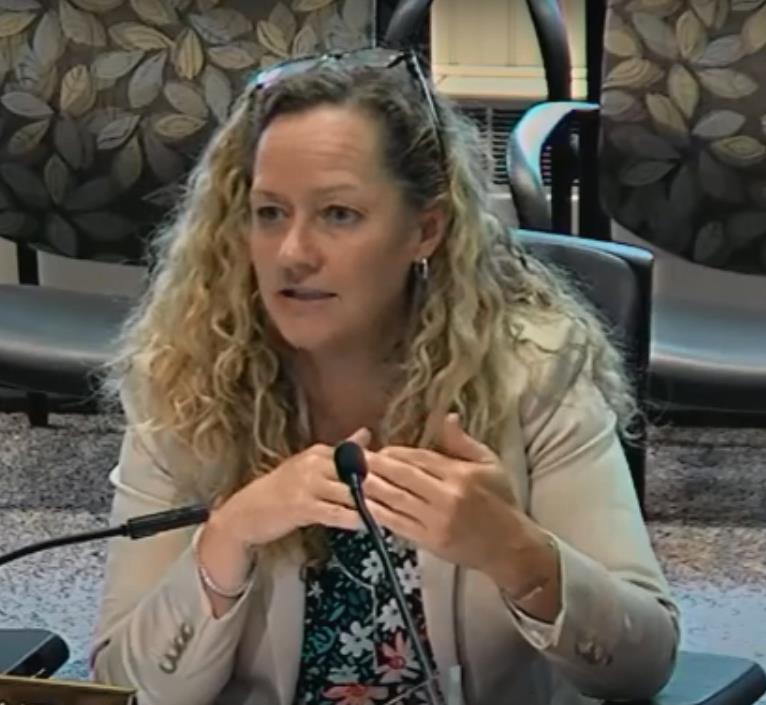
Furthermore, warned McDaniel, “We know without a PILOT, these (community solar, like Norbut’s) projects will not take place.”
Moreover, with incentives through the State agency NYSERDA having ridden a roller coaster in recent years—with those subsidies to community solar projects having now plummeted to zero—the Director admitted it’s hard to peg a PILOT’s price tag right now.
At the time the IDA set its 2016 policy, said McDaniel, “we recognized solar was changing. The regulations were changing, and I would say they still are. It’s like the Wild West here in New York.”
Presenting NYSERDA’s bungee-bounce time-line graph to the IDA, Norbut said he was fortunate enough to have locked in Enfield’s subsidy at 11 cents per watt a few months ago, just before the agency’s money ran out. By comparison, in 2015, the incentive was nearly four times that rate.
“I don’t know how they think they’re going to meet their climate goals,” observed Robertson, critical of the State’s subsidy stinginess in depriving aid to community solar.
Fellow legislator and IDA Board member Mike Sigler answered that he suspects New York is banking on those much-larger “industrial solar” projects, subsidized under a different scheme, two or three of them likely coming to his own town, Lansing. In fact, Sigler cautioned that if the local agency sets PILOT rates too low for smaller projects like Norbut’s, it might establish some sort of precedent to mislead regulators in taxing their larger counterparts.
****
But later that evening, at the Enfield Town Board meeting, Councilperson Lynch took note of the 2017 “trough” that had dropped compensation so low that new solar projects had effectively stopped. NYSERDA then moved in to prime the pump. It was priming that didn’t last.
“Guess what,” Lynch told his Board, “The money’s run out. The incentives have run out. And it’s back in the trough again. You talk about authorizing something on the sweet spot. Well, this is the sour spot. Right now it’s a sour spot. And what I’m hoping that maybe in a year or two, if the Biden administration comes through….”
Councilperson Jude Lemke cut Lynch off in mid-sentence.
“It won’t be a year or two. It will be effective immediately,” Lemke said. She foresaw solar subsidies likely to be part of any multi-Trillion Dollar infrastructure bill that might be adopted by Congress.
“Immediately, maybe in a few months,” agreed Lynch. But he then turned back to the Norbut PILOT currently before the IDA and the Town:
“This is a 30-year agreement…. If we lock into it at the low point of the cycle, we’re stuck with it for 30 years. Maybe there’ll be a better plan that everybody will gain. The Town will gain. Norbut will gain. And the people will gain because they will have more renewable energy. I’m all for it. It’s just we’re in a sour spot right now.”
Yet the Town’s in a “sweet spot” in one respect. Wednesday’s Enfield rebuttal to the IDA passed unanimously.
“I don’t know if you know the politics of Enfield,” Legislator Sigler had told his IDA colleagues hours earlier. “To get the people together in a room is hard enough,” he said. “And to actually get them all to agree in a letter, I think is kind of a big deal. They want it to go a certain way, and I respect that.”
###
From Goldenrods to Hard Hats; Library Place construction may restart soon
by Robert Lynch, July 15, 2021
Yes, as suspected, it was lack of financing, not just contractor delays, that forced developer Frost Travis to impose a more than one-year pause in restarting his company’s Library Place housing project at Court and Cayuga Streets in downtown Ithaca.

Despite the developer’s prior explanations and puffed-up optimism—spokespersons twice setting restart timetables they couldn’t meet—Heather McDaniel, Administrative Director of the Tompkins County Industrial Development Agency (IDA) revealed the true story Wednesday (7/14) to the IDA’s Board of Directors.
“Financing has been secured. Financing has closed,” McDaniel advised the IDA Board in her update on Library Place. “They have re-bid the project. It is getting ready to tee-up for construction.”
McDaniel said she’d “heard rumor” that work could resume as soon as next week. But she quickly added, “My guess is August.”
Since commencing its $31 Million project in December 2018—beginning with the controversial demolition of the Old Tompkins County Library amid concerns about asbestos contamination—initial work at the Library Place site has been limited to preparing foundations and the erection of several concrete-block stairwell towers, eyesores that have blighted the DeWitt Park neighborhood for well over a year. Construction wound down well before the onset of the COVID-19 pandemic, during which Governor Cuomo’s executive orders had mandated all such construction cease. But when the Governor lifted his stop-work mandates, work on Library Place never resumed. Weeds now sprout around the concrete pilings. Promotional banners may hang from the fences. But never does one find a construction worker at the site.
“COVID contributed to the developer’s delays,” McDaniel explained to this reporter after Wednesday’s IDA meeting. Before the pandemic, she said, Travis-Hyde used self-funding to initiate construction. The practice, she said, is commonplace. But then, McDaniel continued, steel prices rose, and when COVID hit, the banks shut down, refusing to lend. Only now, McDaniel said, with the post-pandemic economy reopening, has the developer found an institution willing to lend.
McDaniel declined to identify the financial institution Travis-Hyde will use, suspecting the information remains proprietary.
But what no one can avoid acknowledging is Travis-Hyde’s refusal to come clean with the true reason for its nearly 18-month delay. Approached by the Ithaca Voice last September, developer Frost Travis laid the blame on general contractor LeChase Construction’s inability to coordinate subcontractor schedules, particularly in securing the all-essential steel rigger. “[We] lost our place in the queue with LeChase’s subcontractors,” Travis told the Voice’s Brian Crandall. Travis analogized the contractor’s plight to that of a couple planning a wedding:
“You book the photographer, the caterer, the reception hall, the pastor to do the vows, and so on,” Travis told Crandall. “But then an emergency arises, and you have to put the kibosh on those wedding plans. The emergency comes to pass, but it’s going to be a big effort to get all those vendors and service providers re-booked. After all, they have other weddings to tend to.”
What Frost Travis failed to remind Crandall, however, is that the photographer, the caterer, and everyone else for that matter, expects to be paid. Small detail.
During his September 2020 interview, Travis forecast resumption of work that December. Of course, that didn’t happen. Reporter Crandall revisited the project last month. In a June 7th story, the Voice quoted a developer’s prepared statement—upon which no one chose to elaborate—indicating that “the project will be resuming construction on June 30th.” Travis-Hyde failed to meet that deadline as well. Its June statement predicted an October 2022 project completion.
Questioned Wednesday, McDaniel said she stood unaware of any major changes Travis-Hyde has made in its Library Place design to satisfy its new investors. However, in its June statement quoted by the Voice, the developer made note of “slight redesigns in the ground floor amenity spaces to accommodate exciting increases in the services available for residents.”
As originally proposed—and as far as we know, still the plan—Library Place would provide 66 up-scale priced senior citizens apartments in its four-story building, its upper floors set back from North Cayuga Street so as to limit the building’s tendency to overwhelm the historic DeWitt Park just across the street. Frost Travis has described the Library Place units as “luxury apartments.” In early 2019, he’d priced monthly rentals at $1,900 for a one-bedroom; $3,000 for a three-bedroom.
In May 2019, the IDA granted Travis-Hyde a tax abatement that would save it an estimated $3.95 Million over ten years. The IDA then estimated that, even with the abatement, the project would generate $1.7 Million in tax revenue over that decade, not to mention the sales tax revenue from purchases tenants would make at local businesses.
Frost Travis’ June statement claimed that the firm has “a substantial waiting list” of prospective tenants. But while the developer actively solicits those who’ll pay rent, it shows every sign of ignoring those who remain merely curious. Its “Updates on Construction” page was last updated on April 30th of last year, when COVID-19 officially shut the project down.
###
Tompkins Airport will seek grant money for transit center
by Robert Lynch, July 15, 2021
Mike Hall wants a piece of the pie.
The Director of the newly-renamed Ithaca-Tompkins International Airport told a committee of County lawmakers Thursday (7/15) that he plans to apply for grant money from a newly-created upstate airport improvement fund. And one of the projects he’d like it to underwrite is a Multi-Mode Transit Center, perhaps the eventual new home of the TCAT bus service.
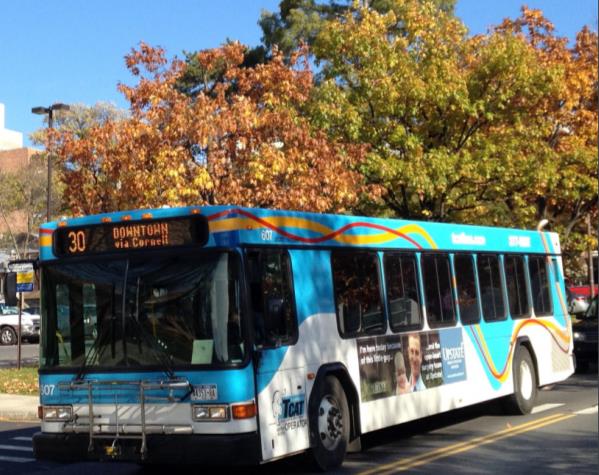
Hall told the County Legislature’s Facilities and Infrastructure Committee that this latest round of new, State-authorized cash totals $250 Million, its total to be parceled grant-by-grant throughout upstate.
“We’ll be spending the next few weeks getting some intelligence about how many awards the State is looking at and what the reasonable share for a community like Ithaca should be,” Hall told the committee.
The Airport Director has his eye on two major initiatives that the local slice of that upstate airport fund might support. One is to provision the airport for converting is ground-based fleet to electric power, constructing charging stations and then linking them by cables to a large solar array somewhere offsite.
The second request, the one to construct the transit center, would involve TCAT, though perhaps not initially. Hall admitted that the Consolidated Area Transit Service, post-pandemic, wants to “reassess their positioning going forward,” and has yet to commit to a new transit center near the airport. But the grant he’ll likely request, would “position” a facility “to eventually accept TCAT.” Meanwhile, it would provide electric bus charging stations and relieve the airport’s current parking crunch.
At times during recent years, TCAT has eyed new facilities to replace the bus service’s aging current home on Ithaca’s Willow Avenue. A new center would, in part, free up TCAT’s current site for high-value housing development. TCAT’s 2018-2030 Strategic Plan acknowledges that the current facilities need expansion. Yet, the Strategic Plan also cautions that “TCAT’s current location, adjacent to its high-demand transit areas, is a great asset that should not be overlooked,” and that a move to a Warren Road airport location would make “operations less efficient.”
Committee member Dan Klein noted that since the pandemic began, TCAT has lost as much as 30 per cent of its ridership “and has not rebounded.” That lack of a rebound has spawned the bus service’s hesitancy about expansion.
Meanwhile, Hall must hustle to get his grant application on file. Though the State announced the grant program only this past May, applications must be filed by September. Hall promised to provide the committee more specificity about his application next month.
Remembering the millions Tompkins County needed to bond to supplement State aid for its supposedly-free new airport terminal, a cautious committee Chair Mike Lane, quizzed Hall about a potential local funding share for this program.
“This time I see a lot less exposure for local money,” Hall assured Lane. The grant might not be awarded for one year, or maybe even two. Furthermore, he explained, “this is elective work,” not a mandated, time-sensitive expense. “I don’t see the need for the County to open its checkbook.”
****
Meanwhile, Hall has another challenge to confront: that of reviving full service food and beverage operations at his terminal.
“The market has changed,” post-pandemic, said Hall. “The airport alone is not sufficient to support commercial food service. You’ve got pulses of people coming through and not enough to sustain a business.”
As a result, the current vendor has closed its kitchen and provides vending machines only.
What used to be, said the manager, is no more. Former walk-in customers, including many of those from the Cornell Tech Park, now work remotely. Food delivery services have proliferated. And those arriving and departing from the terminal do so too sporadically.
Hall told the committee a new vendor must be found. For the current operator, said Hall, “It’s just not working for him from a business point of view.” The vendor will likely terminate his multi-year contract early.
Any new vendor, said Hall, will need to take “a different approach,” perhaps merging in-person service with off-site catering so as to keep preparation staff busy between those “pulses” of demand.
###
Terms-of-Office Hearing Postponed Two Weeks
by Robert Lynch, July 14, 2021
Caught in the tangle between virtual and in-person meetings, Enfield Town officials suddenly Wednesday (7/14) postponed a Public Hearing on proposed changes in the term lengths of three elected Town offices, doing so only hours before the hearings were scheduled to be held.

“Bummer,” was the apt and descriptive word Enfield Supervisor Stephanie Redmond used when she advised her Town Board early Wednesday afternoon that the Board had best postpone the hearings on the advice of legal counsel.
Later Wednesday, when the Town Board met for its regular July monthly meeting, it rescheduled the hearing for 7 PM two weeks later, July 28th.
The Public Hearing, had it been held and when it’s held, will invite public comment on three Local Laws proposed by Redmond. They’d extend from two years to four the elected terms of Town Supervisor, Town Clerk and Highway Superintendent. As written, the laws would not affect those elected officers’ terms until the start of 2024. Terms of those elected this fall would not be altered.
Delay was imposed out of an excess of legal caution. Tuesday evening, a Town Board member observed that the posted Hearing Notice and meeting Agenda still stated the Board would meet via zoom, a procedure the Board has utilized since COVID-related precautions and gubernatorial waivers made virtual meetings permissible under New York law.
But Governor Cuomo ended those waivers in late-June. When he did, the Board became legally mandated to meet in-person, in Enfield’s case, at the Town Court building, formerly called the Enfield Community Building. The Board still allows virtual attendance for spectators, but it cannot for voting Board members. The confusion arising from both the announcement, and the earlier-purchased legal advertisement, caused some to question whether the Hearing, were it held, would fulfill the requirements of State Law. Redmond and Board members decided it would be better to wait.
Aside from Town officials, few knew in advance of Wednesday’s Hearing postponement. Only one or two showed up in person to speak at the Hearing. They politely returned home or remained to discuss other matters before the Board.
In contrast with a pair of elective office changes in 2020, changes that would then have made the elected Clerk and Highway Superintendent appointive positions, this year’s proposed revisions have so far generated little controversy. Once the Hearing is held, and only if the Town Board decides to adopt the Local Laws, would the revisions be placed on this year’s November election ballot.
Last year’s proposed changes lost at the polls by margins of approximately four to one.
###
County Broadband Study proceeds despite concerns about accuracy
by Robert Lynch, July 8, 2021
Only four per cent of Tompkins County’s rural residents lack adequate broadband Internet. Do you believe that low a number? Many don’t.
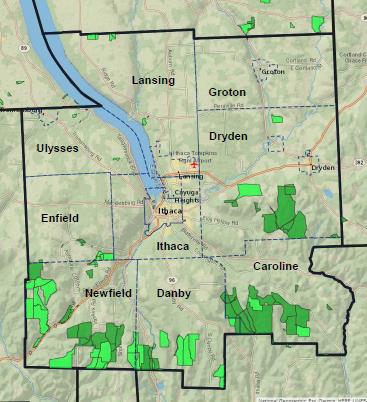
Nonetheless, that same, arguably flawed four per cent premise is what a County-sponsored—and partially Enfield- and Newfield-funded—intermunicipal study will operate under as its consultants design a plan to ensure almost every rural resident has access to high-speed Internet… someday.
The four per cent figure surfaced June 17th as consultants presented their interim “Market Assessment Study” to the Broadband Committee of the Tompkins County Council of Governments (TCCOG). The entire TCCOG membership heard a summary of their report one week later. (This writer is a member of both municipal groups.) The study’s architects conceded their seemingly tiny percentage of underserved people vastly understates the digital divide that faces the county’s rural population. Yet those experts still have every intent to proceed unabated, to rely on the flawed estimates rather than wait for more reliable data to come along.
“That’s not even close to accurate,” Zack Lind, the Ithaca City School District’s representative to the Broadband Committee, blurted out to the consultants. “I’m skeptical.”
Lind’s skepticism took aim at assumptions any critic could cite in support of the adage “garbage in; garbage out.” A table included as a Market Assessment PowerPoint exhibit claimed that only 78 households in the entire Ithaca City School District were truly “underserved,” even when using the study’s exacting standards.
As for other school districts, 273 households were tallied as “underserved” in Newfield; just 21 in Trumansburg; and a mere three in the Odessa-Montour system. The study sets minimum acceptable Internet service as 100 megabits per second “using cable or fiber technology.”
During the June 17th briefing, consultants dismissed satellite Internet services—including Elon Musk’s SpaceX Starlink experiment—as “not a viable substitute.” DSL, satellite and wireless services are “inherently unreliable” said Blake Stovall, Engagement Leader for Fujitsu Corporation, one of the study’s lead partners.
Then, again, Stovall and his colleagues have reason to spleen against any Internet connection that’s not hard-wired. Fujitsu’s study partner, the non-profit Southern Tier Network (STN) envisions stringing its cables to connect the study’s underserved homes and then linking those areas with “middle-mile” trunk lines into STN’s five-county network. STN, as they say, has skin in the game.
Yet don’t expect STN to serve only those remote, scattered splotches of rural real estate; the dead spots where the underserved few live.
“It’s not sustainable in the long term just building to the underserved,” Stovall advised the committee. “The build has to go to other parts of the county,” he said. Otherwise, there’s an “insufficient client base.”
So to link those underserved pockets and make the system work, expect any constructed STN network to string cables in places already served and to compete head-to-head with existing providers.
****
But back to that four per cent figure: Why, when so many rural Tompkins County residents complain of the dial-up doldrums, do the statistics show fewer than one-in-20 among us as being underserved? It’s because of a flawed assumption lying at the study’s core.
For convenience—and no doubt, economy—STN and Fujitsu remain content to rely on fundamentally erroneous FCC data, coverage criteria that get no more “granular” than the size of each U.S. Census Block. Under the FCC’s broad-brush standard, if just one home within a census block—its perimeter bounded by roads or rivers—receives high-speed Internet service, then everybody within that block supposedly gets it. You think? Of course, the methodology vastly overstates broadband’s true reach.
“The data is not 100 per cent accurate,” Stovall admitted to the committee.
“This data is not accurate enough,” the Ithaca Schools’ Lind fired back.
At least two rural towns, Newfield and Lansing, have already sought to correct the data’s inherent flaw by commissioning—and paying extra for—a separate consultant to survey their towns’ roads and provide the Fujitsu team additional evidence to improve their accuracy.
“We will use supplemental town data,” said Stovall acceptingly. But pressed further, the study rep saw no need to hold up the Fujitsu/STN study so that each municipality could supplement its own records.
A revised timetable now places completion of the more than $80,000 Fujitsu/STN study at some time before year’s end. Construction, if feasible, would follow. No one predicts a build-out timetable.
Another finding shared with the Broadband Committee revealed how much the rating one gives his or her Internet provider depends upon where that person lives and whose provider one has. And in that regard, residents in Newfield may envy their Enfield neighbors to the north.
Customer satisfaction statistics presented gave Spencer-based Haefele Connect (serving Enfield) an impressive rating of 3.7 out of five. Ontario Trumansburg Telephone Cooperative, serving Ulysses, came in at 2.8. But down in the cellar stood Newfield’s principal provider, Spectrum Ithaca. Spectrum rated just 2.3 points out of five.
“Haefele is one of the highest rated regional providers,” Fujitsu’s Ray Diaz remarked.
But what did commenters say about Spectrum?
“It’s over-priced, with terrible customer service,” said one commenter, and it’s “Internet that cuts out all of the time.”
“Spectrum says ‘our advertised speed is what you get,’” one meeting leader assured the Broadband Committee. The problem may be in your connection; maybe your router, he explained
“I question that,” said the Ithaca District’s Lind.
****
Then, there’s the final, albeit all-important question. It was raised by Councilperson Joanne James at her Newfield Town Board meeting July 8th: Will this study even solve the real problem; that four per cent problem?
“I’m worried black holes would still need to be served,” James said, fearing that given what consultants shared at their meetings, the STN lines might still never reach some of the remote areas whose residents’ problems were meant to be solved in the first place. And a disproportionate number of those disadvantaged reside in James’ own town.
“We must wait on the study,” a patient—albeit cautious—Supervisor Michael Allinger responded.
“I’ll believe it when I see it,” interjected Newfield Councilperson Christine Laughlin, the most skeptical of all.
###
Speed Bumps on Bank Street? Unlikely
by Robert Lynch, July 8, 2021
David Humphrey blames the roundabout.
The Bank Street resident addressed the Newfield Town Board Thursday evening (July 8th) and urged the Town consider installing speed bumps along his street to slow the speeding traffic that he maintained has worsened since New York State installed its traffic roundabout at the intersection of Route 13 and Trumbulls Corners Road.

“Traffic has been shifting,” said Humphrey. “A lot more people have been using Bank Street to get around the school zone (on Bank Street’s parallel route, Main Street, where the school zone is 15 MPH).”
“I would like speed bumps between the traffic circle and the Covered Bridge to slow these people down,” Humphrey pleaded.
Humphrey mentioned yet a second problem that he said the DOT’s supposed improvement, the roundabout, has created. He called it “Drifting.” Drivers, he said, “hit the gas and spin their wheels all around the circle.” Humphrey suggested a traffic camera be placed at the circle to aid enforcement.
The Town Board took no action on Humphrey’s request. It probably won’t.
Highway Superintendent Kevin Berggren essentially nixed the idea of speed bumps, saying they’d pose a traffic hazard of their own.
“We can’t put speed bumps along Bank Street, not in a 30 mile-per-hour zone,” the Highway chief argued.
In Berggren’s opinion, at 30 miles per hour, a driver could hit one of the bumps, “lose control, and hit one of the houses.”
Reminded by Humphrey that the City of Ithaca calms traffic in 30-mile zones, Berggren countered that Ithaca is different; more urban, with generally slower traffic, and with bumps often located near schools.
In reality, however, many of Ithaca’s bumps are quite distant from schools. And the Town of Ithaca has installed calming bumps along both Judd Falls Road and Warren Road, the latter road’s sections quite rural.
Newfield Supervisor Michael Allinger offered that the better short-term remedy along Bank Street and the roundabout is probably better enforcement.
****
Thursday’s was the first in-person meeting of the Newfield Town Board since the end of the Board’s retreat to online meetings during the COVID-19 pandemic. Like Enfield, Newfield plans to offer a hybrid arrangement allowing guests—and perhaps, eventually, Board members—to attend virtually and also to stream meetings online.
However, unlike Enfield, the Newfield Board is not yet ready to flick the switch. At Thursday’s session, wide screen monitors remained boxed at the back of the room. Before they go up and get connected, members want to paint the walls, and the streaming consultant (the same person as Enfield uses) must interface the electronics.
Allinger expects all will be in place to enable hybrid attendance at the Board’s next meeting, July 22nd.
###
Exactly Whose Recovery Strategy is this, Anyway?
Analysis by Robert Lynch, July 7, 2021
The sky’s the limit,” Heather McDaniel crowed with boundless optimism, though facts forced her to acknowledge the slumping office market. “We want to ensure that our economy… comes back stronger and better than it ever was before.”
Some in her audience chose to be a bit more grounded.
Billed on the agenda as a 10-minute presentation, the president of Ithaca Area Economic Development—the rebranded Tompkins County Area Development Corporation—stretched to two-thirds of an hour her back and forth with members of the Tompkins County Legislature Tuesday night (7/6) as she outlined a post-COVID Economic Recovery Strategy for Tompkins County. So super-positive was McDaniel’s message, one could have mistaken it for a time-share sales pitch. And the development promoter’s PowerPoint quickly showed itself as the product of closed-loop, group-think and bore a decided bias in favor of City of Ithaca interests.

“A number of us stakeholders,” said McDaniel, “spent a significant amount of time last year talking to other stakeholders, to section leaders, to businesses, to policy advocates, really trying to understand the new challenges and the new opportunities as the result of the pandemic.”
“It is not the Ithaca Area Economic Development plan, it is our county-wide plan,” McDaniel insisted.
The logos of Ithaca-centric business promotion groups, including the Downtown Ithaca Alliance, “Visit Ithaca,” and the County Chamber of Commerce, peppered McDaniel’s PowerPoint slides, So did the City’s seal. And the message’s central theme always pointed its compass needle in Downtown’s direction.
“A thriving downtown center is essential to retain and attract business, workforce, and investment all over the county,” McDaniel stressed. Infrastructure investments, she argued, benefit not only city residents, but also “those who drive into the City of Ithaca to work every day”… from Groton… and from beyond.
Never once did McDaniel specifically request the County Legislature fund her initiatives with tax dollars, or maybe with the federal stimulus. She didn’t have to. One easily drew the inference. The “short-term initiatives” outlined in McDaniel’s proposal would cost $1.3 Million, about half borne by the City. But the long-term investments, totaling more than $5.3 Million, would only assign the City about a third of the expense.
And the initiatives the Recovery Strategy sought bore all the signs of a poorly-prioritized hodge-podge of ideas tossed into a hat. Most notably, the only short-term infrastructure priority listed was that West-End “couplet” traffic change that would make a single block of Buffalo Street one-way eastbound and supposedly divert westbound traffic to Court Street. It’s controversial. And City Alderperson George McGonigal piped up from the visitors’ gallery saying the couplet had no place in the plan. Afterward, in the vestibule, McGonigal had a blunter (and unprintable) description for the couplet, equating it to something you might shovel at a race track.
Likewise, the long-term infrastructure wish list includes something called “micro-mobility,” funding to the tune of $600,000 a bike-share program. Pressed on the point, McDaniel said the initiative would likely reprise the short-lived “lime bike” program, only this time, run locally; and also, yes, with scooters.
“I would caution being part of a bike share, including scooters,” said liability-cautious legislator Shawna Black. “They have them in Providence right now,” she reported. “And I can tell you the scooters are absolutely everywhere—in driveways, in the waterways—and people are driving them like absolute lunatics.”
Both Black, who represents the Ithaca Town, and her colleague from Dryden, Martha Robertson, faulted McDaniel’s Recovery strategy for its City-heavy emphasis. “I don’t think many of these (proposals) would have any effect on my constituents,” said Black.
Robertson said she felt the City would not bear its fair share of the cost, while receiving at least half of the benefits. Robertson also raised her argument made the previous week that the federal government’s Rescue Plan awards the City of Ithaca as much as $526 per resident, while Tompkins County only $180.
Not lost on Robertson’s fellow Dryden lawmaker, Mike Lane, was the perceived blunder McDaniel’s organization made when earlier this year it bonded its name with the county seat and turned it away from everyone else.
“When your organization changed its name, it sent a terrible message to the area outside of the Town of Ithaca,” said Lane. “And I think you folks need to do everything you can to explain how these various projects… are going to help people in the rural areas.”
Always positive—albeit tipped briefly off balance—McDaniel answered, “Point well-taken. We did not take changing our name very lightly.” But then, quickly rebounding: “New name; same mission.”
###
People… or Bricks? Tompkins County’s ARP dilemma
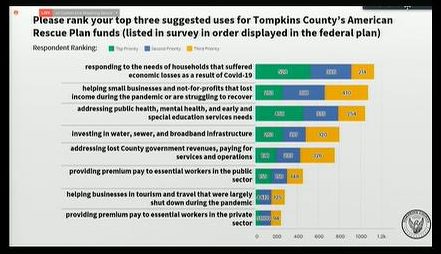
by Robert Lynch, July 4, 2021
“This is like Sophie’s Choice,” said one survey respondent.
“This is like a multi-dimensional Rubik’s Cube,” remarked veteran lawmaker Martha Robertson, addressing her fellow Tompkins County legislators.
What all must agree—or agree to disagree—upon is how to spend $19.8 Million in American Rescue Plan (ARP) funds that the federal government will plop into Tompkins County’s lap bit-by-bit over the next few years. And following more than three hours’ discussion Wednesday (June 30th), meeting as a committee-of-the-whole, members of the Tompkins County Legislature could easily opt to spend the money one way, and constituents choose to spend it quite differently.
ARP basics: Washington sets the program’s ground rules and demands the money be re-spent within any (or all) of four broad categories. For example, the County could use the ARP cash to respond to the post-COVID needs of households and small businesses. It could provide public or private sector essential workers premium pay; think bonuses. Or lawmakers could replenish lost government revenues, providing, that is, that the money was then directed to a qualifying program. Yes, there’ll be mountains of paperwork. And local officials must spend all the funds by the end of 2026.
But judging from Wednesday’s discussions, the public vs. political divide falls over whether to honor the presumed spirit of the ARP handouts—helping people—or whether County Government should squirrel away this one-time, Uncle Sam handout with an inordinate degree of green eyeshade frugality. Shall we satisfy the public’s desire to bail out people and businesses? Or shall we bow to politicians’ preference and warehouse the windfall as so-called “Cash for Capital?” That is, should we tuck it away in some accountant’s unsexy corner and assign it to lower the debt service on future mounds of concrete and brick, including that nearly $20 Million Downtown Office Building? See? Sophie’s Choice.
Evidence that the average citizen would put people first draws documented strength from a hurriedly-prepared, governmentally-drafted, and imperfectly circulated community survey, one posted online over just 13 days in late-June. It drew nearly 2000 responses. More than 1100 of those respondents (or 57 per cent) ranked among their top three (of eight) choices to use ARP funds to compensate households that suffered economic loss from COVID-19. Fully 27 per cent of respondents ranked it as their first choice.
Close behind, at 54 per cent for a top-three ranking, came giving post-COVID help to struggling businesses and non-profit agencies. Using funds to address public health, mental health and early and special educational services came next in line with a top-three ranking of 53 per cent. Investing in infrastructure, like broadband expansion, did no better than four-out-of-ten, as did shoring up government revenues. Awarding premium pay to public or private essential staff fell dead last. Sorry, bureaucrats, there’s little sympathy for you.
Yet, the survey’s architect conceded the snapshot poll lacked scientific rigor. County Communications Director Dominick Recckio declined to draw any “themes” from the survey, “because I think certain groups shared the survey around encouraging their populations to fill it out,” he said. Recckio detected “copy and pasted answers.”
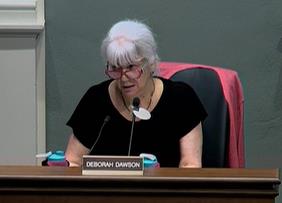
But while the survey’s semi-scientific majorities placed top priority on aiding the hard-hit, a healthy crop of County legislators—including Budget Committee Chair Deborah Dawson, a fiscal hawk—preferred filling the capital fund’s coffers as the simpler, more prudent approach.
“I think that we should bear in mind that politically it’s going to be impossible for us to justify increasing our tax rate this year because people are hurting,” warned Dawson. “And the popular perception is that the County’s swimming in money.” Dawson’s nicknamed herself “Debbie-Downer” in the past.
“But my preference for Cash for Capital investment,” Dawson explained, “is that it reduces our debt service payments going forward ten or 15 or even more years. And thereby it turns one-time money into smaller amounts of money that are available every year for a long time into the future.”
Enfield-Newfield legislator Dave McKenna took a similar stance. McKenna would put “three to five Million” of the funding into improved broadband infrastructure, and the rest into capital. “Fifteen Million frees up 15 Million” in the budget, McKenna observed. “That way you can spend it to make other things feel better.”
But might locking up Rescue Plan millions in a blind, open-ended capital account then tip the scales in construction’s favor, making discretionary projects, like the Downtown Office Building, ever- more of a foregone conclusion? Might it skew governmental priorities and starve the services people really like? Lansing Republican Mike Sigler worried it could.
“I haven’t heard anybody pipe into me saying we should use this on buildings,” remarked Sigler, “like nobody!”
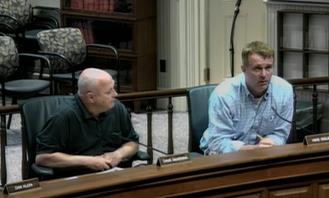
“I hear things like mental health. Yeah, I probably think that’s about right…. Even potholes—that’s what people talk about. They’re cool with that. That’s not a building. That’s great, [they say] I don’t have to go to the shock absorber place this week.”
Sigler continued. “People are watching this. How are you going to spend this? And I think they kind of want us to spend it on stuff that directly impacts them like right now; or at least as quickly as possible.”
Sigler’s colleague, Ithaca Democrat Leslie Schill, shared a similar view, though phrased differently.
“Obviously we could spend it now and be done,” said Schill. “It would be easy, efficient, quicker. I don’t know that that is necessarily taking care of the needs…. There are needs of households, individuals, businesses. I have to think we’ve gotta’ make sure that we’re attending to those. This was a highly unusual, unprecedented situation, and some folks are really struggling. We’ve gotta’ help.”
The meeting’s agenda Wednesday called for each of the 14 legislators to hand forth a “vision statement” that would then be read, perhaps without attribution. Lawmakers backed away from their planned, impromptu prioritizing. Some wanted to revise their thoughts. Dryden’s Mike Lane refused to submit his “wish list” at all until he’d digested more public comment. Members agreed to hand in rewrites by the following Monday.
But however the Rescue Funds eventually get spent, there’s a “manna from heaven” mindset that pervades the whole process. Tompkins County’s finances survived COVID-19 better than first thought. The Finance Director now projects sales tax receipts this year will top pre-pandemic 2019 by nearly a full percentage point. County Government’s unrestricted fund balance, effectively its money in the bank, actually grew during the last, troubled year by $1.8 Million. People may be hurting—the survey bears out the sentiment—but County Government, leaner, if not meaner, sits pretty.
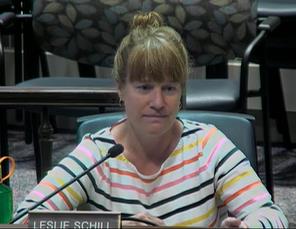
So, Debbie-Downer Dawson would rather hoard Uncle Sam’s cash in that capital accounting cubby-hole and let it pay benefits later. “I don’t want people ten years from now on this Legislature to look back and say what did these people do with $20 Million? And why are we hurting now?”
Yes, at least on paper, using Uncle Sam’s convoluted—and locals would say, misleadingly pessimistic—formula, County Government lost $27.4 Million in revenue during COVID. But that, said Deputy County Administrator Amie Hendrix, relies on the feds’ mandated “counterfactual” revenue calculations. Nope, that word isn’t in my dictionary, either. But I did find the evening’s other $50 word: “tranche.” It defines the step-by-step installments by which the ARP will pay us. Pay us, that is, providing we don’t fight one another to the death deciding first what to buy.
###
Exploding houses (their prices, that is) overtax Assessment staff
Posted by Robert Lynch, July 1, 2021; updated July 2, 2021
“Things are pretty scary right now,” County Assessment Director Jay Franklin anxiously advised a committee of local lawmakers Thursday as he cast his long and privileged look upon the spiraling cost of local real estate.

“Anyone who’s been in this business longer than me has said they have never seen a market like that here in Tompkins County,” the Director candidly told the County Legislature’s Government Operations Committee. “I have examples of many properties being listed $100,000 more than our assessment and selling for $70,000 more than the list price.”
“It’s a market that’s just snowballing right now.”
Whether that “snowball” will just keep on rolling, or whether it may, instead, soon melt, the unprecedented spike in local real estate prices these recent months has brought with it twin troubles. And one of those problems impacts Franklin’s own department. Depleted of staff from cuts brought on by COVID-related austerity, Franklin now has too few people on payroll to keep all his assessments current.
The director warned the committee Thursday (7/1) that unless he receives three new positions later this year, hires costing County Government perhaps a combined Quarter Million Dollars, he’ll likely stop reassessing properties annually and revert to a multi-year, fractional valuation scheme; something, he said, he’d hate to do and that his office has not done since 2007.
While holding off drafting a funding Resolution until next month, a majority on the Government Operations Committee expressed in-concept support for the extra staff so as to keep to the annual, full-valuation plan intact. Any new spending would require the full County Legislature to act.
(And even opting for the partial-valuation alternative would likely require a hefty infusion of County cash; perhaps $160,000 more than in the current year’s budget. The money’s needed to compensate for the past loss of good people, recognizing that it takes up to two years to bring a new assessor up to speed.)
Conventional logic holds that rising home prices reflect economic prosperity. But reading between the lines of Franklin’s tempered comments Thursday, one was drawn to a different view: namely that the local “seller’s market” may be reaching its limits of rationality.
“There’s a lot of movement right now in something we’ve never seen,” Franklin cautioned the Legislature’s committee.
“The market now is ‘Ask for what you want and hope you’re going to get 50- to-75,000 more.’”
The Director brought with him examples:
- A 1,400-square foot, one-bathroom, three-bedroom house on Ithaca’s Utica Street: Assessed for $280,000; never listed for sale; but sold for $523,000.
- A home on Cornell Walk: Assessed at $400,000; listed at $449,000; and sold for $610,000, more than $150,000 over list price.
Why the land rush mentality? The Assessment Director credited several factors. “A lot of people made a lot of money during COVID,” Franklin said. Interest rates are low. Foreign investors have entered the mix. “A lot of institutional buyers,” he said, are simply “looking to put money in their pocket at the end of the [tax-dictated] holding period.” And compared to traditional investment, the Director added, “That’s difficult for me to reconcile.”
Plus, there’s one other factor pushing up the price tag of existing housing stock: “It’s very, very difficult to build here,” Franklin said. Zoning laws are such that, he said, “You have to know the right people.”
On the commercial side, Franklin pointed to the sale of the City Centre downtown high-rise. Nearly new, it cost $50 Million to build. Now it’s sold for $75 Million, the price amounting to $350,000 per rental bedroom. Another project, this one in Collegetown, sold for $63 Million, or $224,000 per bed.
But does that mean we should all cash in; speculate? Franklin’s between-the-lines message to the committee implied, well, not so fast.
True, said Franklin, if you bought a property just last February, “you got a deal on that property,” because it’s worth so much more money today. But on the other hand:
“I don’t want to tell somebody that their property is worth more today because I think they’ll be able to sell it for more in 20 years. That may be an investment decision that they make, but I don’t think that’s something that I can do. I would have to look at what the income stream is and see what value [the property] should be.”
****
Which brings one to that second problem brought on by the Tompkins County real estate bubble; the rising assessments—and taxes—foisted upon those homeowners who have no intentions to sell.
“My concern is actually for folks that aren’t selling their property, but want to continue to live here,” said County Legislator and Government Operations Committee member Leslie Schill. “When their assessment is tied to those ballooning sale prices that may or may not be continual or realistic in post-COVID cooling markets potentially, it’s difficult.”
To that, Franklin answered that Schill’s concern underscores his need for annual revaluation. Because, he explained, if all assessments rise in unison, and government spending remains constant, the tax rate applied to each rising assessment should show a corresponding decrease, leaving tax bills unchanged. However if some assessments are raised, but others are not, imbalances occur, leaving some taxpayers paying more; others less.
“The most fair and equitable way is a full-value, 100 per cent assessment,” Franklin insisted.
###

